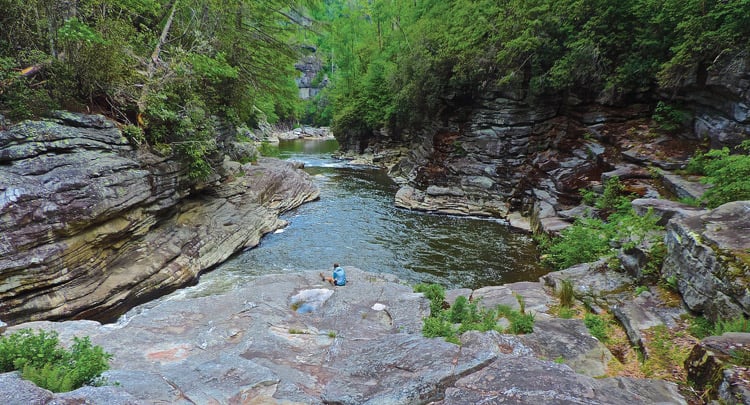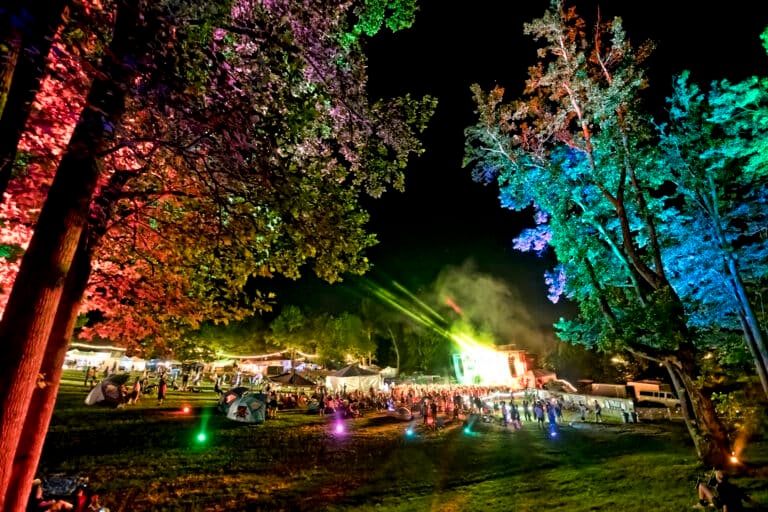Awesome: The Surprising Science Behind How We Experience the Outdoors
A cold front is sweeping over Pickem Mountain in the Jefferson National Forest, blasting a gale-force wind through the cliffs crowning its summit. The weather has my attention, but the trio of kids I’m hiking with are too busy to notice. They’ve got other business.
“Is this where the salamanders live?” one of them asks, wandering towards a rock outcrop off-trail. I don’t know, but we check it out anyway, shining a headlamp into a narrow crevice midway up. Sure enough, the snub-nosed profile of a green salamander peers out at us.
The kids are certifiably stoked. “Let me see!” they yell, pushing past each other to get the best look. One of them has his jaw dropped, while another is chattering excitedly about the salamander’s behavior. The third is silently staring at the animal, processing a part of the woods they’re seeing for the first time.
There’s a common way to describe each child’s reaction: the kids are in awe.
We’ve all experienced that feeling. It might not come from something as specific as a salamander in a rock crevice, but each of us has stumbled across one of those outdoor moments that leaves us gobsmacked. Maybe it’s waking up to a backcountry sunrise over a sea of valley fog, or perhaps it’s surviving a ride down epic singletrack that straddles the razor-thin line between exhilaration and a trip to the E.R. Regardless of the source, there’s an undeniable feeling in finding awe in the outdoors. We’ve experienced something different, and it won’t leave us the same.
Why does that feeling happen? After all, emotions have biological sources, and awe is no different. In recent decades, psychologists have been delving into the science behind awe-inspiring experiences in nature, shedding new light on an emotion that everyone experiences but few easily understand.
Much of that insight is coming from the Great Outdoors Lab, a collaboration between the Greater Good Science Center at U.C.-Berkeley and the Sierra Club. Previous work has shown that a feeling of awe stems from expanding one’s horizons—experiencing something different that forces you to reconsider your world—but an outstanding question has been if that experience translates into longer-term wellbeing.
And as humans become more disconnected from nature, that question becomes even more relevant. “Most of our population lives in cities, and more and more we’re spending all of our time in front of screens,” says Craig Anderson, a postdoctoral fellow at U.C.-San Francisco and formerly a graduate student at U.C.-Berkeley. “Awe is an emotion that we feel in the presence of vast things that take us out of the context that we’re used to, and nature is really good at both of those things.”
Anderson and colleagues tested that ability in research published this past summer, examining diaries kept by whitewater rafters including college students and military veterans. Their results were striking: more awe-inspiring experiences outdoors can lead to improvements in well-being and stress responses, including those tied to PTSD.
While it makes sense that a single event like a rafting trip would generate transformative awe, Anderson and colleagues went a step further, asking participants to keep diaries detailing their thoughts and feelings as they went through everyday activities. Out of a list of positive emotions—amusement, contentment, joy, and pride—awe was the one most affected by regular time spent outdoors.
“Those daily moments, whether it’s a sunset or noticing flowers blooming in the neighborhood, those can make you feel awe, too,” Anderson says. Over the two-week course of the study, participants who felt more awe in nature saw greater improvements in their well-being.
Those of us who spend time outdoors know that feeling all too well. But why are the outdoors so primed for inducing awe in the first place? It turns out that a love for nature might be rooted in our DNA. For decades, researchers have known that humans are drawn to natural landscapes. As far back as 1984, biologist E.O. Wilson popularized a concept called the Biophilia hypothesis, which Wilson called the “urge to affiliate with other forms of life.”
Work since then has suggested that our attachment to nature often links to places that support psychological notions like safety in an environment or the exploration of it. While some debate exists about how extensive those preferences may be in different populations, experiencing awe in nature is very likely a part of what makes us human.
An added implication of Anderson and colleagues’ research is that our relationship to nature might also extend to our health. And the medical community is catching on to that notion. In recent years, medical professionals have begun prescribing time outdoors for a litany of health conditions. In Japan, a form of outdoor therapy called forest bathing has been linked to lower blood pressure and reduced diabetes risk. Here in the Blue Ridge, the region’s wilderness therapy programs are based on similar principles, as are a growing number of nature therapy centers regionwide.
Granted, you’re probably never going to get a script from your doctor that simply says “go do something awesome.” But researchers are uncovering that there’s real scientific grounding behind that feeling of experiencing awe in nature, whether it’s a thru-hike on the A.T. or getting amped about spotting some salamanders with kids on an afternoon walk. The secret to a long and healthy—and yes, awesome—life, then, might lie no farther away than right outside.








